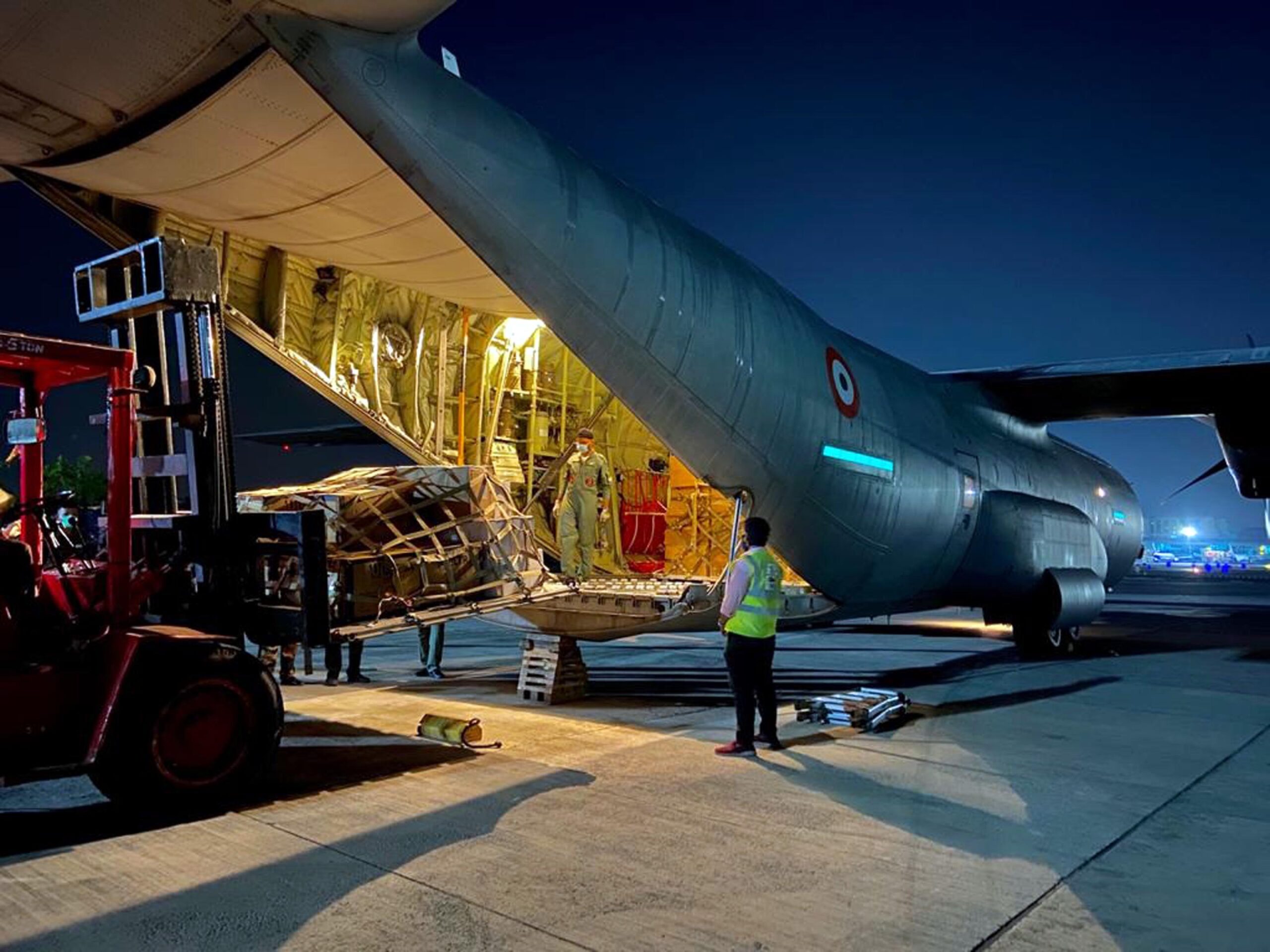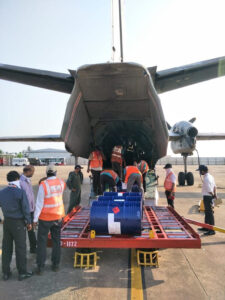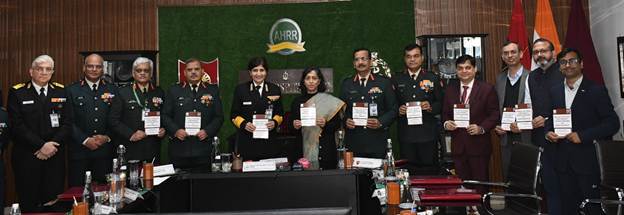
 Visakhapatnam: The Indian Air Force has airlifted 8.3 T of essential chemicals required to effectively control the gas leak that occurred at Styrene Monomer Storage tank in LG Polymers plant here on the early hours of May 7, the Defence Ministry stated on Monday.
Visakhapatnam: The Indian Air Force has airlifted 8.3 T of essential chemicals required to effectively control the gas leak that occurred at Styrene Monomer Storage tank in LG Polymers plant here on the early hours of May 7, the Defence Ministry stated on Monday.
The IAF operation took place on Saturday following the request from Industries and Commerce department of the Government of Andhra Pradesh. It deployed two An-32 transport aircraft to airlift approximately 1100 kg of Tertiary Butylcatechol and 7.2 T of Polymerization Inhibitors and Green Retarders from Mundra, Gujarat to Visakhapatnam (in Andhra Pradesh).
These chemicals were required to reduce the toxicity of the gas being leaked from the storage tank. The IAF also facilitated the move of Director, Indian Institute of Petroleum from Delhi and a specialist on Styrene Gas from Mumbai to Visakhapatnam. “The two individuals were required to oversee the operations being undertaken to control the gas leak,” the ministry stated.
Also read:
PM reviews situation as 11 die in Visakhapatnam gas leak incident
Vizag gas tragedy is not the first such incident to take place there
[the_ad_placement id=”content-placement-after-3rd-paragraph”]
In the meantime, the Visakhapatnam-based environmental activist and general secretary of Jana Sena Party, Satyanarayana Bolisetty made a representation on Monday to the state government appointed committee to investigate the cause and impact of the accident in which 11 persons had died. Bolisetty, in consultation with expert in Chemical Engineering, Professor KV Rao, raised the point that the land of the plant in itself was in litigation with the government. They asked whether it was possible that this plant, which stores and uses hazardous material, could operate without the consent of the Ministry of Forest and Environment?

“We have made a Checklist for the enquiry to be conducted on Vizag Gas Tragedy, based on the information related to this particular accident and more specifically with regards to Seyrene vapour,” Bolisetty stated. The questions that he and Rao raised before the committee were as follows:

1. Why the tank of 2400 MT capacity filled with styrene monomer had not been monitored during lock down?
2. Did the management of LG polymers bring this matter to the notice of the District Collector about the need for monitoring due to impending danger of auto-polymerization of Styrene Monomer?
3. What were the instructions of the management while shutting down the plant because of lockdown? Did the operations manager discuss the issue of auto-polymerization in the tanks with the management?
4. On Penultimate day, did the operating personnel check the tank? If yes, what was its condition? If no why it was not checked?
5. Was there any mechanism to check the vapor leaks from the tank?
6. What was the temperature of the tank on Wednesday night?
7. Knowing the temperature and situation of the tank, did the management implement any onsite emergency plan?
8. Who prepared and who approved the onsite emergency plan?
9. Is there any copy of such plan?
10. Were all operating personnel concerned trained in implementing the plan during emergency in the plant?
11. Who is the chief incident controller according to the plan?
12. What were the pre-emergency preparations on Wednesday night?
13. Was any complaint received about styrene vapours leaking from the tank? Many employees living nearby. Did any one report on the smell of styrene on Wednesday or Tuesday?
14. It had been told on aTV by the representative of the management that the breather valve was opened to save from the burst of the tank due to pressure build-up. Is it true?
15. Wednesday night from 11 pm to Thuursday morning 3 pm, were golden hours to control the incident. How were those precious hours utilized ?
16. Why there was no siren? No alarms to the public?
17. Why the management could not warn local people?
18. Did any such incidents of auto polymerization of styrene in storage tank/ tanks take place on site in the plant? Was it recorded in the logbook? How was it controlled?
19. What is the status of the second tank? Why there was no auto -polymerization?
20. Who designed the storage tanks for styrene? Who certified the design?
21. Who issued the license for the storage tanks? Ministry of Commerce & Industry: DPIIT? How many years back the licence was issued?
22. Are there any copies of the designs with certification and license?
23. Has the tanks got all the provisions for measurements and facilities as given below?
i. Temperature/ Temperature Proflle along the height. What kind of sensors used? Are there any pressure guages located on the tank? Where are located? What is the range and accuracy? Does it display on control panel? Are there any previous logs?
ii. Refrigeration system: dedicated to the tank or refrigeration unit for whole plant? If it fails, what are the alternatives to cool the tank? Any other cooling system in case of emergency?
Was it in working condition during the vapor release?
iii. What is the material of construction of the tanks? Are they lined? What is the lining? Are the tanks taken for annual maintenance? When did the last maintenance take place? How is the polymer formed during regular storage removed?
iv. Is the tank atmospheric? What is the vent size? What are the functions of breather valves? If it is closed tank, is there any safety valve? What is goose neck and its function? How much pressure rise in the tank acceptable?
v. What is the inhibitor to arrest polymerization of styrene in the tank? How its concentration is monitored? What is its depletion rate per day in the tank? How it is analysed during its monitoring? Is LG polymers having process control laboratory? What should be the minimum concentration of inhibitor? How much inventory is maintained in the plant? How it is charged to the tanks?
vi. What is the chemical added to the tank to terminate the radical polymerization in the tank at high temperatures? How is it charged? What must be the quantity? What is its inventory in the plant to meet the exigencies?
vii. Is the tank provided with a recirculation system? What is the type of pump? Is there any standby punp?
viii. Blanketing the tank with nitrogen: is there any provision of Nitrogen blanketing? Is there any Nitrogen producing unit in the plant?
ix. What is the Oxygen level in the vapor space to make the inhibitor effective? How is it monitored?
x. In case of severe auto-polymerization of styrene, to dilute the contents, ethylbenzene is used. Is it available in the plant? How much inventory is maintained in the plant?
24. It is mandatory to provide three layers of safety to protect the procese or storage from runaway reactions?
What are the nature and types of safety layers provided to the tank or tanks?
25. How much quantity of styrene was there in the second storage tank before lockdown? What happened to it? Why auto polymerisation did not take place in the 2nd tank.
26. What is the daily requirement of styrene monomer to manufacture PS and EPS? How many days required of styrene is stored in the tanks?
27. From where the styrene is imported? How is it transported to the plant and transferred to the tanks?
28. Are there any operation manual and standard operating and maintenance procedures? Can the copies be provided?
29. Was there any safety audit done on the tanks? When it was done last? Are the reports available? Who had done the safety audit? Were there any remarks?
30. Who were the operator and supervisor in the night shift on Wednesday (06.05.2020)? Were they trained in operation and maintenance of styrene storage tanks? What is their experience in styrene plants? Can they narrate the happenings from 11 pm to 3 am? Can a report be given to the committee?
31. How many operating personnel and other staff were present in that shift?
32. Any HAZOP and Risk assessment was carried out on storage tanks when the original molasses tanks were converted as storage for styrene? Are they available now?
33. Is there any separate safety department in the plant? Who is safety engineer? Has the safety department been conducting safety programs or periodic safety audit? Any reports available along with meeting proceedings?
34. Any ISO certification was done? When? What is its validity?
35. How ambient air is monitored for styrene concentration onsite and offsite? Any logs are available? What were the average concentrations of styrene?
36. What are the PEL and IOLH, LC-10, LC-50 values of styrene vapour?
37. What are the probable concentrations of styrene vapour in the 3 km radius from the source point?
38. How many plant personnel were affected during the styrene vapour release.
39. What are health effects of styrene vapour on people, Cattle and other animals/
40. Does the company provided MSDS to operating personal? Can a copy be submitted?
41. Is the company having a health care centre and a qualified doctor? Dies the heath care centre maintain the health history of employees the health history of employees including workers? Any previous history of severe ill-health of the employees due to work in styrene environment?
42. How many minor incidents occurred in handling storage and processing of styrene? Is any record available?
43. What are the flammability limits of styrene vapour? What is its NFPA classification
44. What are the facilities available at the plant site to deal with accidental fires and explosions due to styrene? How many layers of defence provided to prevent tank fires and explosions?
45. Are all the operating personal trained in firefighting?
46. What is the safety record of the LG Polymers?
47. Is there any work permit system?
48. Had any work carried on tanks of in its premises from May 4 to May 6th? If yes, details may be provided.
49. How many chemical engineers are working in the plant in shifts the list of total chemical engineers working in the plant at different levels? Can the data be provided?
50. Has the LG Polymers got a Technical services department? Has they carried out any modifications in the recent past?
51. What is the budget allocation of LG polymers for safety in the plant?
“We shall be happy to meet you and submit any further information as our Jansainiks (party workers) live in the villages adjacent to this LG Polymers plant and some people belonging to their families suffered casualties and a few of them died in this accident,” Bolisetty and Rao wrote.[the_ad_placement id=”sidebar-feed”]





